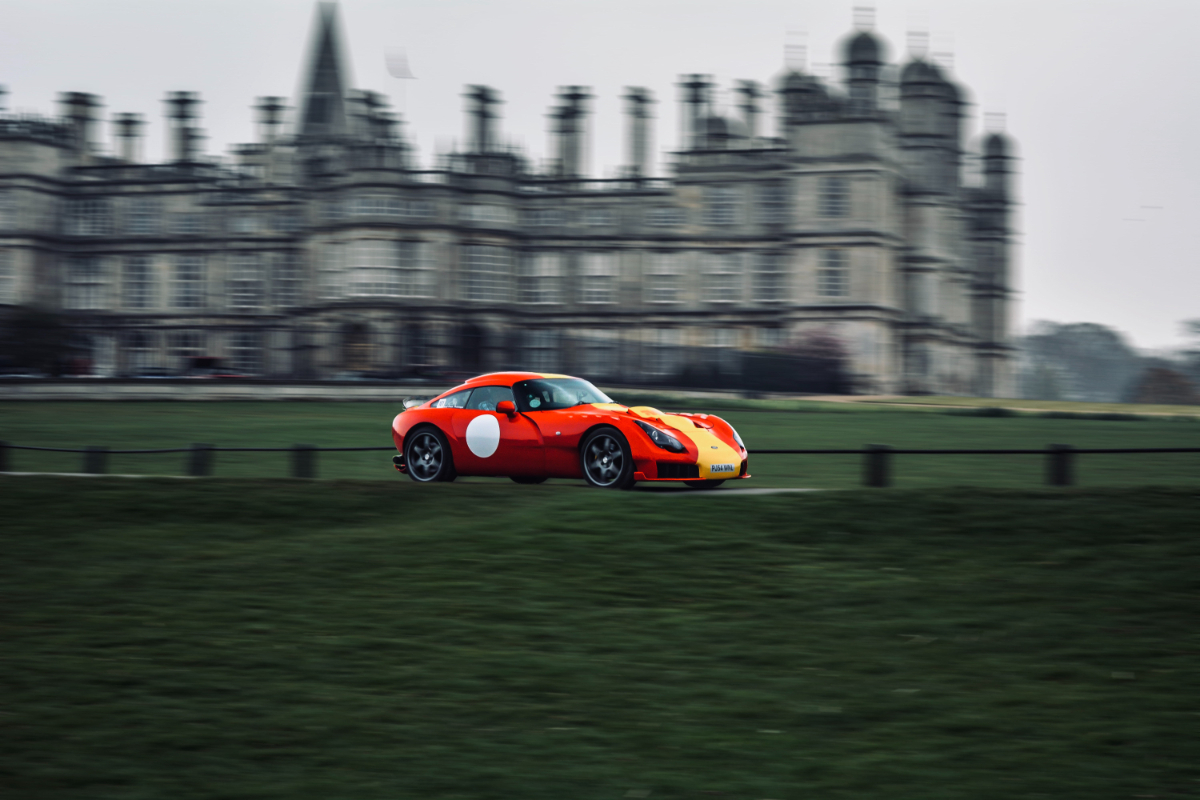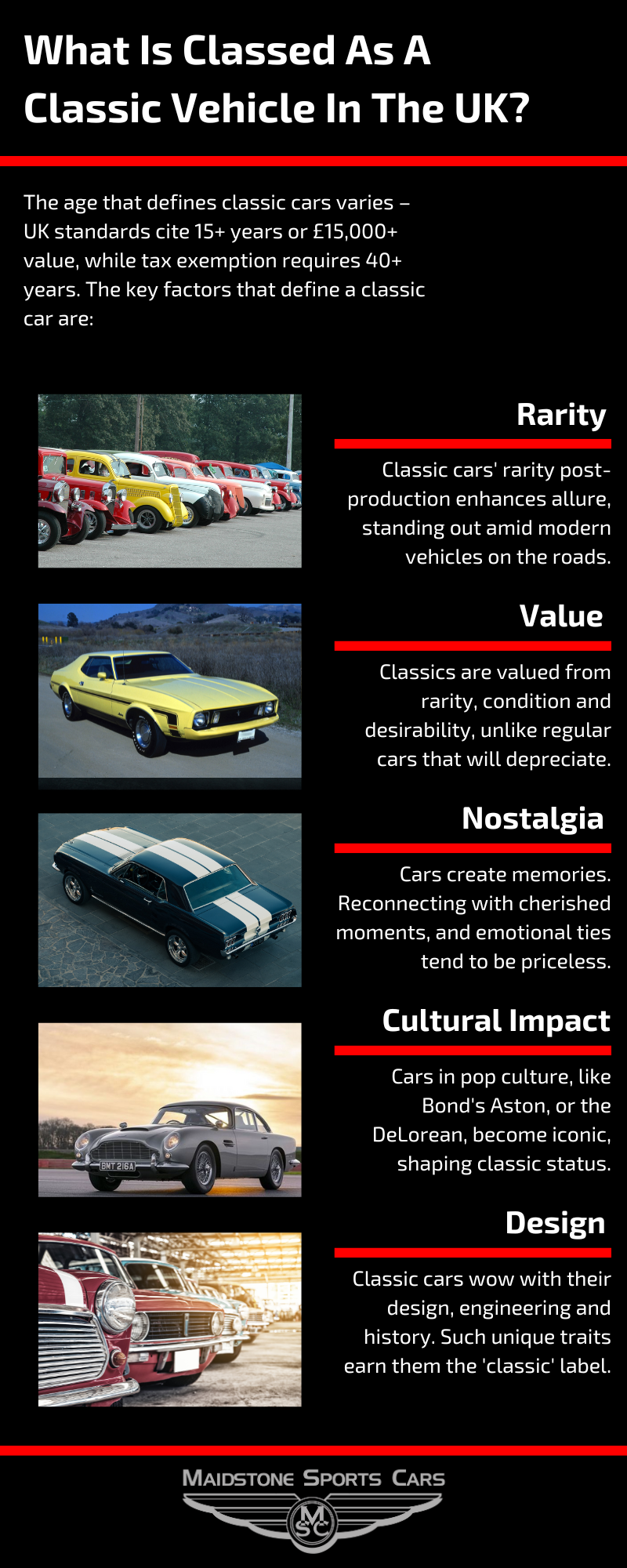What is classed as a classic vehicle in the UK? Find out what qualifies as a classic vehicle according to UK regulations. Explore the criteria, benefits, and implications of owning a classic car. Get expert insights on preserving automotive heritage and navigating regulations.
What is a classic car?
Defining a classic car transcends its age; it encapsulates a rare blend of exceptional qualities that elevate these automobiles above the ordinary. Let's delve into the factors that render classic cars truly exceptional and set them apart from their contemporary counterparts.
Rarity: A pivotal criterion for classic cars is their rarity. Having ceased production, they are a rare sight on today's roads. This scarcity enhances their allure, distinguishing them amidst the sea of modern vehicles.
Value: Classic cars exude timeless appeal and are cherished as valuable investments. Their worth is influenced by factors such as scarcity, condition, and overall desirability. Unlike ordinary vehicles that depreciate over time, classic cars' value remains steady or even appreciates, making them coveted possessions for collectors and enthusiasts alike.
Wow Factor: Classic cars possess an undeniable wow factor. Be it their elegant design, exceptional engineering, prestigious marque, storied history, or distinct personality, each classic car boasts a unique combination of traits that merit the esteemed 'classic' label.
Nostalgia: The emotional connections associated with classic cars are profound. Many enthusiasts hold dear the cars they grew up with or yearned for when first developing a passion for automobiles. Nostalgia plays a vital role in solidifying a car's classic status.
When does a car become a classic?
The allure of classic cars, from the timeless elegance of a sixties E-Type to the enchanting charm of a first-gen MX5, is simply irresistible. But what truly defines a car as a "classic"?
This guide untangles the riddle by exploring the typical age range of classic cars, their defining features, and key considerations in identifying these automotive treasures.
Classic cars' ages vary widely due to different criteria set by authorities and organizations. In the UK, HMRC considers cars over 15 years old, priced at £15,000 or more, as classics.
.jpg)
For tax exemption, the vehicle must be at least 40 years old. In contrast, the Antique Automobile Club of America designates classics as vehicles older than 25 years, with those over 45 years called antiques. Insurance providers have their own classification systems. Determining the exact age of classic cars is a complex task given these diverse definitions.
In essence, a classic can be any age, provided it predates most contemporary vehicles, with a significant milestone being the year 1946. Cars produced after this date are typically considered classics, while earlier ones are often deemed vintage. A key characteristic of classic cars is that they are no longer in production, representing captivating relics of a bygone era. Over time, certain models gain recognition within the motoring community, securing their status as classics.
What makes a car a classic?
The enchanting title of "classic" is bestowed upon specific car models by devoted enthusiasts for an array of captivating reasons, setting these vehicles apart as timeless treasures. Let's delve into the key factors that contribute to a car achieving the revered status of a classic.
Nostalgia: The powerful pull of nostalgia plays a pivotal role in defining classic cars. Certain models have the extraordinary ability to evoke fond memories of bygone eras, reigniting childhood joys or cherished moments. Whether it's a memorable ride with a petrolhead uncle or an enchanting visit to a captivating car show, these experiences forge emotional connections with particular vehicles.
Design: Aesthetics hold considerable sway with car enthusiasts, often trumping what lies beneath the bonnet. Quirky design elements like bench seats, fender mirrors, or iconic shark fins contribute to a car's allure and elevate its potential to attain classic status.
Cultural Impact: The indelible mark a car leaves on popular culture can thrust it into the pantheon of classics. Vehicles featured in iconic films, beloved TV series, or influential fashion trends become symbolic representations of their respective eras and continue to shape opinions on what defines a classic. Think of James Bond's sleek Lotus Esprit S1 from "The Spy Who Loved Me," the time-travelling DeLorean from "Back to the Future," or even Ron Weasley's flying Ford Anglia from "Harry Potter."
Thrill Of The Ride: Tangible aspects significantly influence a car's claim to classic status. The exhilarating thrill of the ride, the captivating sound of the engine, and the tactile pleasure of gripping the steering wheel all contribute to a car's allure and enduring appeal.

When does a classic car become valuable?
The value of a classic car extends beyond its age. Not all old vehicles hold the allure of true classics; for instance, the Renault Laguna lacks the desirability associated with classic cars.
The factors that truly determine the value of a classic vehicle include its condition, rarity, popularity, and perceived quality of the model. Condition plays a crucial role; a well-preserved classic car, free from rust and safe to drive, becomes highly collectable.
Rarity is another significant aspect; the fewer vehicles that were produced and the fewer that have survived, the higher its value. Popularity also plays a part; a high demand in the market elevates a classic car's worth.
Moreover, the perceived quality of the model upon its introduction can impact its long-term value. As these cherished automobiles withstand the test of time, their worth appreciates, making them valuable assets for collectors and enthusiasts alike.
What’s the difference between: veteran, vintage, post-vintage and classic cars
Defining a classic car is akin to appreciating beauty - it lies in the eye of the beholder. However, car connoisseurs have outlined general guidelines to distinguish between the various categories of these captivating vehicles.
Veteran Cars: This category includes anything produced before World War I. These automotive pioneers hold a unique historical significance, representing the earliest developments in the world of automobiles. An example of a veteran car is the Renault Voiturette.
Vintage Cars: Vintage cars encompass vehicles made before 1930. They exude an old-world charm, boasting elegant craftsmanship and design from a bygone era. A Rolls Royce Phantom is a prime illustration of a vintage car.
Post-Vintage Cars: Post-vintage cars were manufactured between 1930 and 1945. These vehicles bridge the gap between vintage and classic, showcasing refined engineering and style. An example is the 1935 Talbot 65.
Classic Cars: The definition of classic cars is more subjective, as it involves desirability rather than a specific production period. Generally, classic cars are vehicles that have ceased production but remain highly sought-after and admired. A prime instance is the timeless Lotus Elan, captivating hearts with its enduring appeal.
If you want to find out more about sports car servicing and repair within Maidstone and Kent, then get in touch today.


